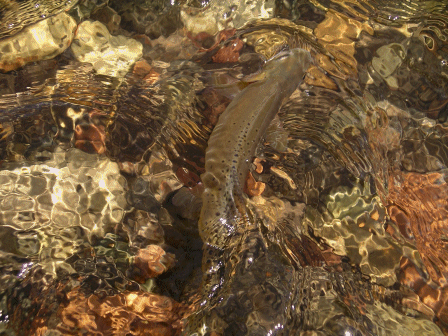
August, 2005
7/28-8/1: The water flow rate on our "favorite" river was sharply reduced this week apparently because of a glitch in the gauging station at the point on that stream we always check, so we assumed it might finally be wadable this summer. I arrived in Glenwood to pick up Sue just after noon on Thursday and because she was stuck at work until 4, I had a chance to get down on the Roaring Fork one more time. This river too is dropping quickly although on this day remained fairly full along the banks.

Walked a half mile below the Sunlight Bridge and began working my way back up river using a variety of rig combinations. Truthfully nothing worked very well at first. A couple of strikes down deep were about all I felt until getting up in the flats nearer the bridge. Changed to a surface gray colored WRS and trailed it three feet with an antenna pupa and finally started having a bit more action.
The river was slightly discolored which probably helped make the resident browns a bit less nervous. Played a handful of that species on the way to the highway and all came to the surface fly. There was not much in the way of insect activity in the middle of the day, but a few caddis did from time to time plop down on the water.
Above the bridge it got much better even though I managed to miss far too many strikes. Virtually every piece of holding water close to the banks held a good fish - all were browns. Played another half dozen nice trout ranging from 12-16 inches.
When Sue got off work we bundled up the dog & headed out on our second vanagon trip of the summer. Because of road construction issues, we decided to take a back road to Rio Blanco Lake & see if the warm water species there were still willing and eager as they've been in the past. That was the case and both of us had plenty of strikes and releases of smallish bluegills. Sue played one larger bass, but it long released.
Camped above Buford, ate a good breakfast the next morning & headed down
to the parking area for the start of our favorite stretch of the stream. Lots of bugs were out on the water even at 9:00 in the morning. Midges
were dominant, but caddis were flitting over the water too and later we saw at
least a couple of mayfly species including red quills and BWO's.
Lots of bugs were out on the water even at 9:00 in the morning. Midges
were dominant, but caddis were flitting over the water too and later we saw at
least a couple of mayfly species including red quills and BWO's.
Stuck with the same setup of flies used on the Fork and they seemed to do the trick. It wasn't fast action at first but did pick up the further upstream we hiked. The rainbows are wonderful here, very strong & fit. Ditto for the whitefish (see photo), but the latter remain something of a pain in the neck due to the way they fight. Even with five pound test flouro those snapping heads pop off many a nymph.
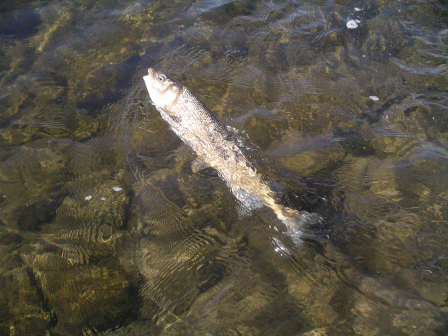
We had very nice success all the way up to our turnaround point. Most of the rainbows and many of the whitefish as well came to the surface fly. Tried going deep in a couple of holes calling for that tactic and again were mostly rewarded with whitefish. Sizes for the rainbows ran 6-16 inches (It's great to see young of class fish in the stream each year). The whitey's ran ten to eighteen inches, and a couple of these were a good three pounds in weight.
Had a leisurely lunch, did some shopping at the Buford store and because of
the unusual number of anglers at our intended afternoon section, decided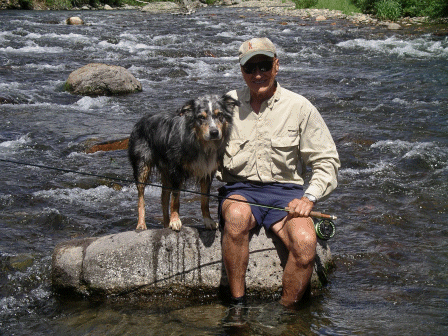 to drive further up the North Fork to check it out. Serendipitous that
decision was as we found wonderful fishing for smaller cutthroats & rainbows
everywhere we parked.
to drive further up the North Fork to check it out. Serendipitous that
decision was as we found wonderful fishing for smaller cutthroats & rainbows
everywhere we parked.
The upper part of this fork is very brushy and can be difficult wading. In places the holding water is highly separated, but when a good stretch is found, it's usually packed with fish, as it was today. We caught all kinds of cuts and rainbows and each of us released a single brookie.
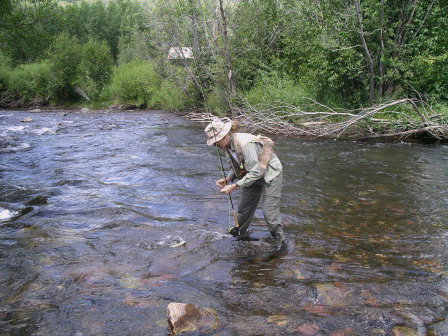 After another nice
night of free camping along the river we headed back to the place we'd avoided
the previous afternoon due to too many other fishermen. Made the cross
stream wade and hiked down to the trough hole which didn't fish nearly as well
this morning as it had the prior day. However, I was pleased to land the
only brown of the trip there which made for a grand slam weekend.
After another nice
night of free camping along the river we headed back to the place we'd avoided
the previous afternoon due to too many other fishermen. Made the cross
stream wade and hiked down to the trough hole which didn't fish nearly as well
this morning as it had the prior day. However, I was pleased to land the
only brown of the trip there which made for a grand slam weekend.
Upstream we separated and while Sue fished a favorite braid of hers, I cherry
picked some of the holding structures a bit further upstream. She had a
wonderful time, probably playing a good 20 plus fish including some nice
rainbows in her water and I released a couple more good bows as well and then a
beautiful sixteen inch Colorado cutthroat.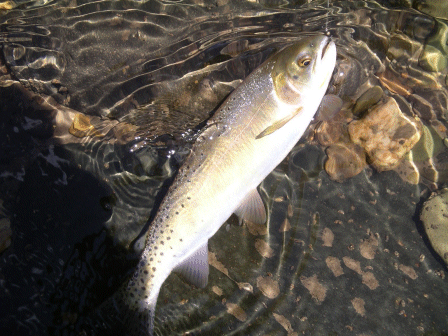
When we got back home we tried another half hour of casting on the Roaring Fork in the hopes of getting Sue her brown to complete the slam, but the fish were completely uncooperative in the 90 degree air temperatures. This river has dropped markedly from when I'd fished it three days earlier and both Sue & I could only muster a single strike apiece while on the water.
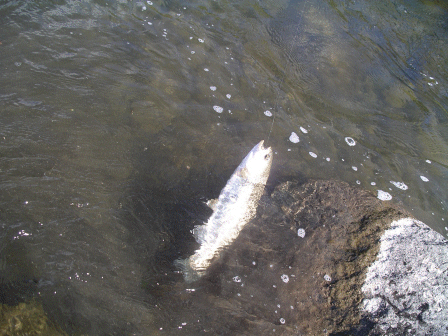
Hopefully the Eagle will be clearing and in shape when we head to the county offices on Wednesday. We've not really been able to easily fish that river yet this year.
8/5-6: Two short outings on Gore Creek Saturday afternoon and Sunday equals one short update report. Tried the Eagle earlier this week, but persistent thunderstorms blew that stream out the only time we had a chance to look at it. The rains stopped yesterday so I drove out to the golf course section & walked a half mile or so of the Gore there. Too much bright sun on the water made the fish very spooky. Noticed that I'd lined and spooked several so stopped and spliced in about three feet more of tippet and that helped a bit. Started getting a strike here & there on both the floating #18 WRS and the trailing #18 antenna pupa. Fish were on the small side and while I eventually released all species but a cutt., nothing was over ten inches in length.
Today was quite a bit better size-wise when I fished in the Lionshead area. This pocket water breeds more opportunistic rainbows and using the same rig as yesterday brought probably a dozen fish to the hooks - mostly to the pupa and the somewhat cloudier weather today seemed to make the fish a bit more cooperative. The fish, all rainbows, ranged from eight to fourteen inches and all looked very healthy.
We'll probably try the middle Colorado next week and may even go back to that tailwater below Shadow Mountain to see if it retains any of the allure it had on the 4th of July.
8/7: An absolutely delightful hour & a half on Ten Mile Creek this morning. We needed to make a tip to Wal-Mart for some extra video cables so opted to go to the one in Frisco instead of Avon to give that named creek a try. Pulled off at what would be termed a pool-drop section of the stream. Sue waded across and immediately hooked a decent fish on her first cast. She was so startled that it popped off instantly. We walked up opposite sides of the creek and cast into small eddies and pools, hooking and releasing smallish browns that came pretty equally to the #18 surface WRS or trailing #18 antenna pupa. Until we ran out of holding water we each probably played a dozen or so browns - all of which were under nine inches. It was fun. Perfect weather and no wind.
Drove a bit further down the freeway and stopped at a somewhat quieter stretch of water with some broader riffles and quieter eddies. It was even better here. Sue released a very nice brookie and we both found rainbows holding on the edges of faster water. More browns followed. By the time we finished up I suspect we'd both played a good two dozen fish apiece in this short period. No other fisher people to contend with either. It doesn't get much better.
8/8: In more or less sharp contrast to yesterday's results, today's were a pretty big disappointment. It was my first prolonged outing on our largest local river, the Eagle, this season. Even though the flows remain quite high - bordering on post runoff levels - this late in the summer, the color was decent, and there was not much excuse for the limited success I had.
Stayed in the red canyon section of the stream and waded across to river left. Caught a small brown in an eddy almost immediately on the rubber legged WRS that I'd tied on as the dry. It was encouraging. Unfortunately that was the last fish to be released for another half mile of wading. Had reasonable numbers of strikes on the surface, but none that I was aware of on the trailing pupa. However, many of these strikes were of the "short" variety indicating some interest on the part of the fish, but also lots of caution. Eventually changed to a #18 standard WRS and had more serious rises to that fly.
Frankly I still think it's something of a waste of time to cast during the heat of the day now. There were a few midges along the banks, but really nothing out on the water except for a handful of caddis around 3 in the afternoon. That may just be an attempt at an excuse to deny my lousy efforts today. Had I connected on 90% or so of the strikes I had, it would have been a very decent outing - but I didn't. Either too much slack line or too much inattentiveness led to my downfall. What's good about the river is that at these higher flow rates the fish are much more spread out than they have been in several years. We'll do better next time around. Wednesday we head back to Williams Fork reservoir for some (hopefully) pike and then to the upper Colorado to see if those fish between Shadow Mountain and Granby are still active in that tailwater.
8/10-11: With a big trip planned for next week, this one was a shorty. The dog & I headed East on I-70 Wednesday morning, gassed up at Silverthorne and drove North to the Ute Pass turnoff, then up & over & down to the inlet area of Williams Fork reservoir. Monsoon season is still upon us and the minute I'd rigged up the pike fly rod, it began to come down in buckets. A half hour of walking & casting the same area where we did well earlier this spring produced not a strike. An inauspicious beginning to the trip.
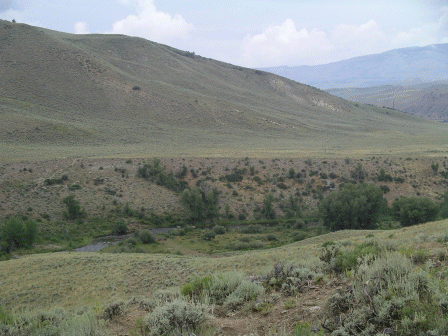
Headed down towards the Colorado, but when there were only a couple of cars in the Kemp parking lot for the Williams Fork tailwater, we decided to give it a hike and a try since we'd not fished it in maybe three or four years. With the hopes that the other fisher people had taken the lower and easier way to the stream we did the mile & a half hike over the upper hill and were rewarded with no other competition for the upstream water on this short tailwater.
I've never really done very well here and today started out exactly like the
previous sessions. Kept switching to smaller & smaller flies and
eventually began to have some success. A #20 gray WRS up front trailed by
a #22 red midge larva seemed to strike a cord with these heavily cast over
trout. Pretty soon we were getting strikes at almost every piece of
holding water & there were some smiles all the way around - at least I
imagined that the dog was smiling too.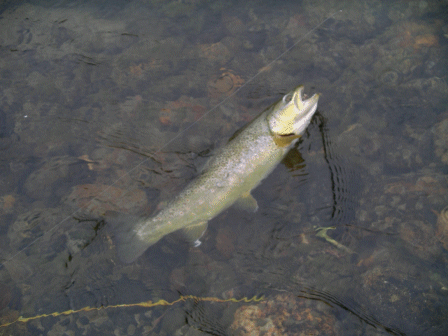
The fish were all browns and ranged in size from 6-14 inches. Most actually came to the surface fly which surprised me a bit. Probably we were helped by the lousy weather which continued on & off all day long. Anyway we completed this roughly mile of wading in a couple of hours and may have released a dozen & a half fish, which I thought was wonderful based on previous trip comparisons.
Made the return hike and then drove to Hot Sulfur Springs for lunch.
Did some wading & casting along the bank just below that town for some of
the nondescript browns that occupy the Colorado there. Only release of
interest was this double hookup - which is always fascinating.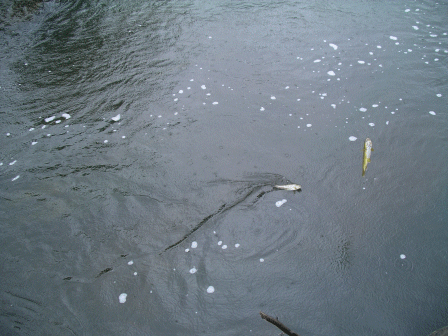
Continued on US 40 to Granby, then North to Shadow Mountain Lake for another try at the tailwater that was so outstandingly productive in early July. Expectations for this water were low due to the reduced flows & remarks by another fishing friend who felt the trout in mid summer migrated down to Granby Lake when the stream temperatures rose too high.
As it turned out, there still were numbers of trout in this water although they were all incredibly spooky. In the bad afternoon light and rain I missed countless strikes - simply couldn't see the #18 WRS on the water. Quickly gave up trying to use a nymph trailer as the moss on the bottom fouled the hook immediately as it struck the water. In fact the surface fly fouled virtually every cast as well. Had to turn to a #22 RS-2 for these picky trout and used the larger WRS as a strike indicator. Suspect releasing a dozen or so smallish browns - all under twelve inches. Just don't know where the nice size rainbows and cutthroats have gone. Probably either further downstream - or as suggested - out to the lake.
Debated camping on Stillwater Pass again but chose to head back to the Byers Canyon area and use one of the free campsites at a dispersed campground down by the Colorado. Found a seclude spot around 6:00, had a quick bit of dinner and then waded the river to try some early evening caddis fishing for the tough browns that live here. It turned out to be a terrific night of casting. Couldn't get any fish to taste whatever nymph I tied on as a trailer so eventually just stayed with the #18 gray WRS on the surface. It worked fine. Found browns everywhere behind structure and in the shallows along the bank. Must have played a good dozen & a half fish in the hour plus I was on the water. Decent sizes too. At least three were in the sixteen inch range. My casting wrist was really sore after ten or so hours of casting today.
Around 2:00 in the morning a thunderstorm broke overhead and it rained for a couple of hours. When we got up in the morning, there was a good inch of water in the dog's bowl outside the car. The river was up too, and while not murky, was certainly discolored. So we tried some new tactics. Cast a wooly bugger downstream (with one strike to show for it) and then turned around using a hopper and trailing stone (no strikes).
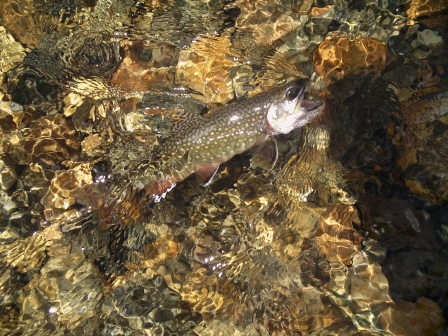
Back towards Parshall we drove and turned back up to Williams Fork, pulling in at the inlet lot. Rigged up small surface and nymph and walked up the stream for a quarter mile or so. It was loaded with small rainbows and browns, but that kind of fishing gets old pretty quickly. Packed up again and drove upstream, pulling off at the upper part of the river just below the Henderson Mill.
With a history of poor results here, it was a pleasant surprise to find lots of activity in this pocket water. More flow seems to make for much better fishing. At the first spot I released a half dozen mixed rainbows and brooks without having to move my feet. Good action continued for the next quarter mile with the best fish being a fourteen inch brown.
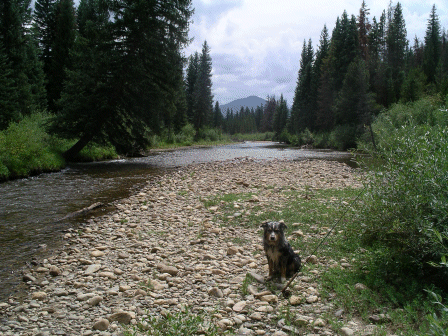
As a last stop before heading home, we drove up the South Fork road and got on the stream at the earliest point possible. Gosh it's an almost achingly beautiful creek up here, not done justice by this photo. At this point the river flattens out substantially and has lots of character and plenty of fish any place there's depth and some kind of cover. Caught three species here - all on dry flies. None were large (over twelve inches), but all were fun and a nice ending to the two day trip.
We'll try some kind of day trip this weekend and then it's off to our favorite river for a couple more days followed by a short expedition to Southwest Wyoming in an attempt to finish off the cutt slam up there.
8/18-20: Sue's USFS two day meeting in Meeker gave us (the dog & I) the perfect opportunity to fish our "favorite" stream, after which, all three of us could continue on North to Wyoming in our ongoing quest for a cut slam in that state. We - the canine & I - arrived on our stream late in the morning & began our regular walk up the part we love best about this river. With time to spare today I waded a braid that historically has not yielded any fish of note whatsoever - and today was no different. A quarter mile of work produced but a single eight inch rainbow to the #18 WRS.
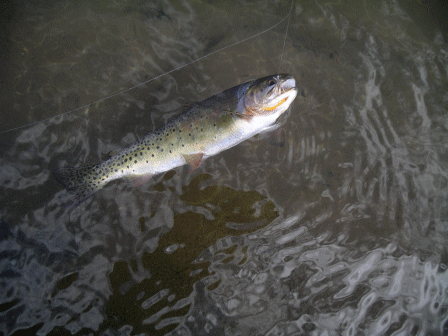 Giving up on
further exploration we then trekked across the island in the river and began
casting where we knew fish were present. And present they were. With
a three foot trailing fly of a #18 antenna pupa strikes came often and
hard. For whatever reason the larger rainbows and cutthroats were much
more active today.
Giving up on
further exploration we then trekked across the island in the river and began
casting where we knew fish were present. And present they were. With
a three foot trailing fly of a #18 antenna pupa strikes came often and
hard. For whatever reason the larger rainbows and cutthroats were much
more active today.
My only problem was trying to take a photo or two of them. Every time I got the fish close to shore and fumbled with the digital camera, the fish flopped off the line. It happened all day long so no pictures are available of any of the decent sized 14-18 inch bows and cuts we were privileged to hook this day.
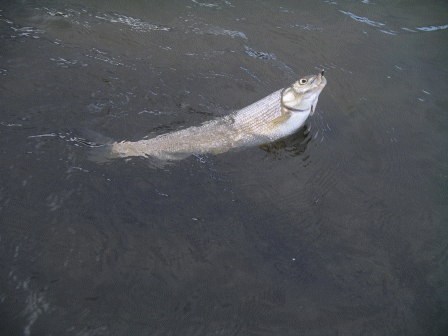
Whiteys were less present and the one good sized one pictured here was all I had to release. In any case the fishing was wonderful. Don't know when I've seen more really large (better than sixteen inch) fish all over the river.
At the top point of my wade just before exiting the stream, I hooked and played a "Henry's" strain rainbow of at least 24-27 inches that easily weighed five to seven pounds. There was no stopping it as it fled downstream and the hook pulled free before I could chase it along the shore. Great finish to the day.
Stayed that evening in an interesting, if not perfect, small (two room) motel in town and had a truly uninteresting dinner at the Hotel Meeker.
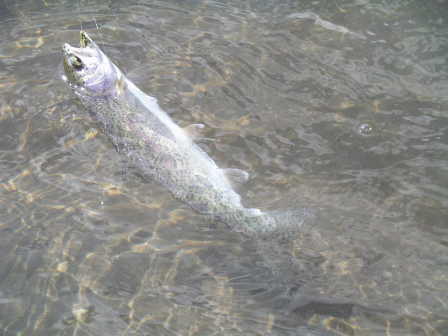
Next day the dog & I did some more experimentation. Drove to the confluence of North and South Forks and waded a good mile or so of each of them. It's very difficult to move along either of these tributaries. Bankside willows and birch make access from the bank more work than is worth describing.
The fishing both places was not much better. The North side gave up a half dozen modest rainbows and I had not a strike on the South. Basically wasted half a day up here but at least learned a lesson the hard way.
Returned to fish some pocket water below the junction of the two forks & had a bit better luck although the fish were very modestly sized.
Then drove back towards town & walked the Prather-Nelson stretch with more very modest success. Fish are much warier down in this more accessible public water & many probably get yanked by the locals even though it's supposed to be catch & release water.
With Sue's meeting running a good 2-3 hours longer than anticipated, Sky & I then headed into town & fished the town park area for a couple of hours. It was fun - at least for a while. Most of the population is whitefish with a smattering of small & largish browns. Every pass through shallower riffles and tight bank water along some riprap brought a couple of strikes and the release of three or four modest browns. Despite discolored water conditions fish came to the surface as often as the took the nymph. Best trout was around sixteen inches.
Picked up the wife at just about 5:00 in the late afternoon & headed North to Wyoming. With the late start we elected to stay in a motel in Rock Springs. It was an unpleasant evening of little sleep due to freeway noise. Left the next morning for Kemmerer and arrived in that town in time for late breakfast, gas, and a few supplies for the cooler.
Given a very short time window (two days on the water), the plan was to try the upper Hams Fork for Colorado cutts. which both of us are missing - and in between try for my missing Bonneville.
The lower Hams Fork has lots of decent access places, but the water there looks better suited to catfish or other warm water species. Suspect some larger browns probably hide in the deep undercut banks, but that strain was not on our menu for the weekend.
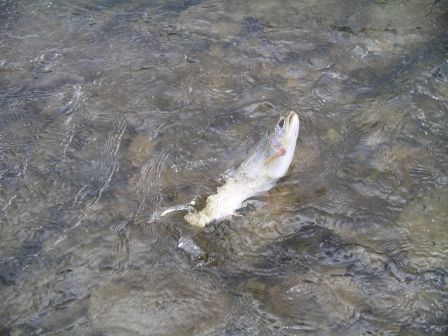
Fifteen or so miles above Viva Naughton reservoir we finally took a stab at some of the willow clogged stream. It actually turned out to be very good fishing - if one likes tiny rainbows. In the space of less than an hour Sue estimated to have released 30+ rainbows, all of which were under seven inches in length. My results were very similar.
In one small dip between climbing several divides we found a perfectly
gorgeous spring entering some creek for which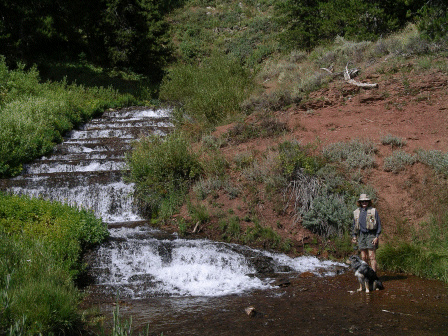 we cannot find a name. The spring is appropriately called "Big"
and it was very photogenic. Unfortunately we could find no sign of any
insect or fish life downstream of the spring. Perhaps that's why the basin
is called "Poison Hollow".
we cannot find a name. The spring is appropriately called "Big"
and it was very photogenic. Unfortunately we could find no sign of any
insect or fish life downstream of the spring. Perhaps that's why the basin
is called "Poison Hollow".
So we continued on West over the next divide and eventually arrived on the Smith Fork in the Button Flats area.
The road here #232 is undergoing a major revamp and travel at the moment definitely requires four wheel drive. It's a mess. At least we didn't have to deal with rain which would have made the surface impassable. At Collett Flat we rigged up & tried the stream above & below the bridge but could get nothing to strike the many combinations we tried. It was quite discouraging as the river was decent sized here and looked promising.
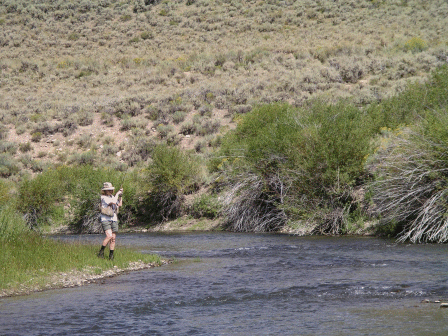
A bit further upstream we chanced taking an unmarked turnoff to the right and happily found the junction of the main Smith and Hobble Creek. One other vehicle was present, so we took off wading upstream using an up & down rig of WRS and pupa.
The fishing was decent, if not outstanding. Just about every piece of
modest holding water gave up a rainbow or two - and I finally landed &
photographed my tiny Bonneville. It was alive and was released.
Happy days.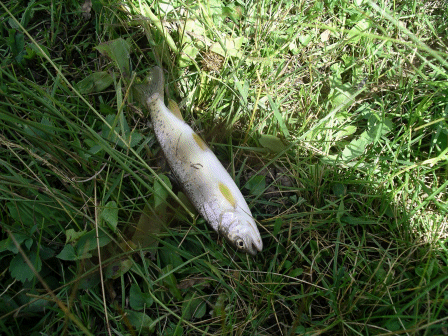
For whatever reason this part of Hobble Creek doesn't seem to have deeper runs or holes, so I suspect larger fish must migrate down below the confluence with the Smith. It's fun fishing however, and both of us wished for more time to explore further downstream as well as across & up the Smith Fork.
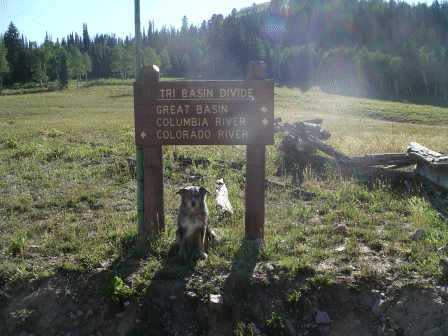
We continued driving up the Dry Fork, got back to one flowing branch of the Smith & fished again for a bit. Sue had a handful of small rainbows but we saw no other cutts. The drive continued on to and through the Tri-Basin Divide and then down to the upper part of LaBarge Creek.
Here a major disappointment greeted us. Signs posted by the Wyoming Wildlife Department warned fishermen off the LaBarge Creek and its tributaries as the department was poisoning most of this area to rid the water of non-native species (everything but Colorado cutthroats). Obviously generalized poisoning is not strain specific, so when we tried various sections of the upper stream and several beaver ponds, we found no life whatsoever. We also didn't come across any dead fish which seemed surprising under the circumstances.
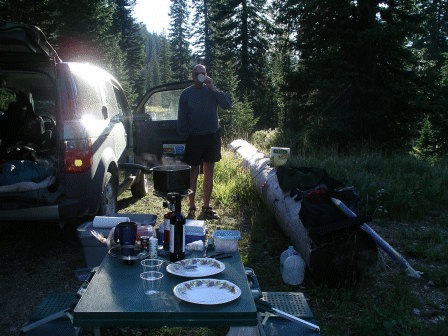
Camped that night on a secluded ridge high above the stream and slept very well in the quiet place disturbed only by a few coyote howls in the morning. Saturday we continued down LaBarge, fishing from time to time without success until we got to our favorite stretch of the lower creek.
Here the fishing was terrific - easily the best we've ever had on this
water. Nice sized rainbows from 8-14 inches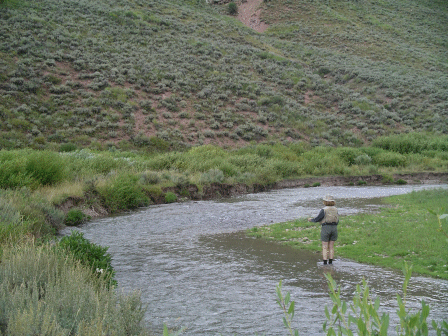 were pretty much everywhere. They loved our smaller grasshoppers and Sue
had excellent success on her pupa as well. Saw a number of larger fish in
deeper pools and later tried for them with a streamer, but they'd have none of
that type fly.
were pretty much everywhere. They loved our smaller grasshoppers and Sue
had excellent success on her pupa as well. Saw a number of larger fish in
deeper pools and later tried for them with a streamer, but they'd have none of
that type fly.
Suspect we'd have done even better with a couple of nymphs trailed at the bottom of those holes, but it sure was fun having them come up for the hopper. As a change of pace, Sue released one large whitefish and I did the same with a smaller brown. Just very nice fishing here.
Drove on down to the town of LaBarge, fueled up & headed up towards Big Piney with the thought of maybe trying one of the tributaries of that creek system. But after looking at the map, we decided not enough time was available to do the necessary driving & exploration so turned back down highway 189 and looked for some access points for the Green - which also supposedly holds Colorado's. Tried our luck at the "Fear" access site. The river braided here and looked wonderful, but we had no success at all on anything we tried. Would guess this time of year might call for early morning or late evening fishing in this water.
More downstream travel eventually landed us at the tailwater area of
Fontenelle Reservoir. We tried this water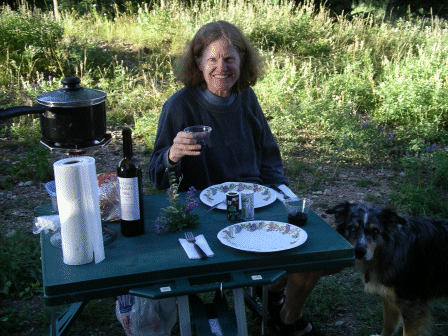 before without success and had that same experience this time around. And
we really worked the river long & hard here.
before without success and had that same experience this time around. And
we really worked the river long & hard here.
Although fish rose from time to time, I don't get the sense that many really are present permanently in this tailrace. Absolutely nothing we tried worked, and we fished off and on through 8:00 at night and again the next morning before breakfast.
I had a couple of meaningless strikes on a hopper near the riprap by the bank, and that was about it. Even throwing a tiny BWO the next morning - after seeing several of them resting on our car when we woke up - brought nothing to the surface.
I just don't understand how to fish this place, and again we just didn't have time to spend hours experimenting. So back home we came on Sunday - with the glass half full from the trip's results. Don't know what next weekend holds yet.
8/24: Today was another of those "Is my glass half empty or half full?" kinds of days. The dog & I took off west on I-70 after lunch, hoping to fish some spot on the Eagle in the lease area. Took the exit at Wolcott & continued downstream. Got to a pull-off in the red canyon section and after looking at the pretty clouded water, decided to retrace our steps back to Wolcott and check out the Colorado by State Bridge.
That turned out to be an even worse choice. The Colorado, while not chocolate colored, was clearly unfishable this day. So we hiked up to the mouth of Piney & began a wade up that nice little creek (despite the fact that it's called a "river"). In the past we've sometimes had good success on rainbows in this part of the stream, but today was an exception. Nothing but a few small browns took the #18 WRS over the first half mile we walked.
To be honest this stream really drops quite quickly near the mouth and that limits holding water for fish. There simply aren't many deep holding pools or other protection for the inhabitants. While browns, whitefish, and rainbows do run up here during their spawning seasons, I suspect most of the mature fish return to the Colorado when the Piney's flow moderates - as it has now.
Eventually we had better success. Some nice runs, although only a foot or so deep, gave up a twelve inch brown and then a similar sized rainbow. Further upstream one stretched out pool yielded a half dozen fish, including the best trout of the day - a fourteen inch brown. Overall, however, it wasn't what we're used to for results on this stream. Better than sitting around watching TV though.
Last Logbook Entry � for previous days
8/30-31: With the Aspens starting to turn we're racing to try all our favorite fishing holes in Colorado before winter closes out the quest. This week it was off to the Poudre to get our "fix" on the waters of that beautiful northern Colorado stream. It's about a three hour drive from Vail to the headwaters area where the river becomes fishable. Along the way there, with two days to burn on this trip, we (the dog & I) decided to take a quick detour up the north Michigan River (creek is a better description) to try that stream around the reservoir.
We found that a true tailwater below the dam was really nonexistent. This seems to be a simple pour over impoundment designed strictly for recreation, and while the lake itself is decent sized, the flow coming over the dam (estimated at 2-5 c.f.s.) did not exactly create anything resembling a normal tailwater. There were some good sized beaver ponds below the dam, but we chose to head above the lake to try the inlet stream. Frankly I had very limited hopes of any success mostly because of the very low flow rate.
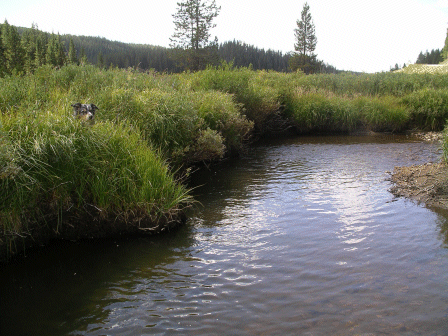
Happily that perceived flow rate didn't turn out to be a problem. The stream has reasonable numbers of nicely undercut banks that harbored "monster" trout of eight to twelve inches. It's fascinating to note the very large numbers of fry and other juvenile fish in this stream. They're everywhere. Virtually any shallow riffle or pool held large numbers of tiny to five inch fish - almost all browns.

Until I figured out that the bigger boys were tucked deep under the banks, I caught all kinds of fingerlings. Eventually by putting the nymph way under the bank (albeit and suffering lots of snagged hooks) the bigger fish were eventually lured into the open. Truly big they were not, but given the size of the stream, I was very pleased by landing a rainbow of twelve inches and the best brown was roughly ten. This is definitely Sue's kind of fishing spot and a place we'll have to revisit next year!
After an hour or so of horsing around here, we headed back up the pass towards the headwaters of the Poudre and pulled off near the crest with the intent of hiking into Zimmerman Lake and try some casting for greenback cutthroats. Alas, the sign at the trailhead indicated that CDOW was poisoning the lake to rid it of some kind of trash fish and that the cutts. would not be available until another year.
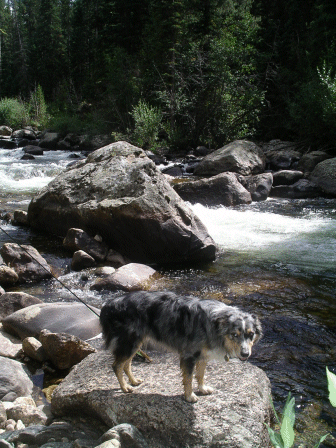
Down the highway we drove until we got to the junction of Joe Wright Creek and the Poudre itself. The trailhead is called "Big South". Leashed up the dog & did a hike up the Poudre to just below the wilderness entrance. Had hoped that we might find something besides the ubiquitous browns that populate the lower Poudre, but it didn't happen. Maybe if we'd continued further upstream, we might have found different species, but this section of the river was strictly a "pool drop" type stream with very limited holding water. Tried a few eddies and caught browns to ten inches in all of them, but the river's just too steep here to find enjoyable casting.
Off we went to some flatter sections down below Big Bend. Was a bit
disappointed by most of the fishing through this stretch though we've had decent
success in the past. Even the classic flat water near the old fish
hatchery was a bust late this afternoon. Just couldn't figure out what
these fussy trout wanted. Tried everything from a #24 nymph to a #8
streamer with only a couple of strikes to show for it.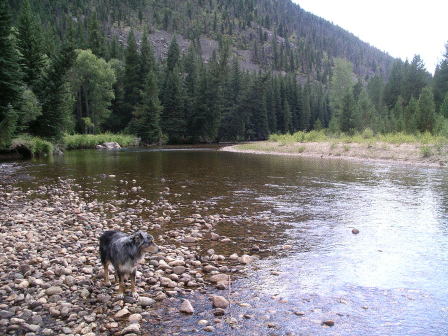
Made several other short stops on the river with modest results and then we did the turnoff at the Red Feather Lakes access road where we camped for the night. By the way, camping spots (free ones) are severely limited on the Poudre. We've found the best places are on this road to Red Feather and that's about it.
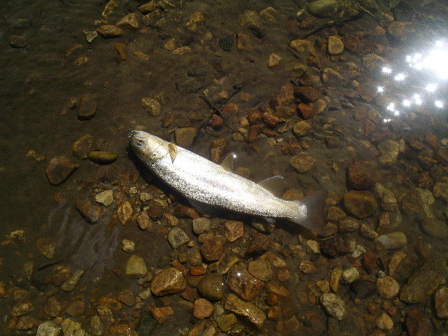
This morning we drove a few miles further downstream and fished part of the Pingree Park catch & release water. It was decent, although I missed five times as many strikes as I hooked up fish. Are my reactions just lousy - or am I really getting old? Anyway this was the only place I landed a handful of rainbows - all under twelve inches, plus a few more browns that got to that length.
On the way back up the hill we tried the very difficult and touchy wild trout water below the hatchery and had much better results - if landing four fish while missing a dozen others constitutes "good" results. For whatever reason the fish seemed to respond favorably to that #18 rubber legged WRS and a couple took a trailing #20 black beetle.
It was interesting that the browns in this stream occupy very different stretches of holding water compared to what we normally find for them. Perhaps it's the late summer lower flows that draw them into riffles and alongside patches of faster water. Some did lay near the banks, but most seemed to be in swifter currents.
What was so interesting on this trip is that I could get nothing to take a nymph. And I really tried most everything in the box. The best fly, for god knows whatever reason, was a #16 or a #18 gray bodied WRS with mini rubber legs. While the fish didn't go wild for it, at least they found it reasonably appealing. Larger hoppers did not work, nor did conventional sparser tied WRS's.
Eventually further upstream a few fish took the #18 antenna pupa, but why they ignored other styles of nymphs, I have no idea.
This was another one of those "half empty, half full" kinds of trips. Not bad, but not what we've experienced in the past. Hopefully we'll get out of this trend of only modest results next month and score some decent wins for a change.
Home, Main Fishing Page, , Eagle River Access, Local Ten Commandments, Successful Fly Patterns